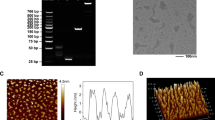Abstract
An ultrasound-adsorption method was used to prepare Bcl-2-SiRNA-loaded PS-mPEG/CaP nanospheres. The size and zeta potential were 18.41 ± 4.31 nm (n = 5) and −23.5 ± 0.6 mV, respectively. The entrapment efficiency of SiRNA was 92.86 %. MTT assay results confirmed that the blank nanospheres demonstrated a negligible cytotoxicity response in H1299 cells. Flow cytometer analysis results demonstrated that PS-mPEG/CaP NSs could carry SiRNA into the cells effectively. RT-PCR experiments and apoptosis assay results approved that, compared with free SiRNA, SiRNA-loaded PS-mPEG/CaP NSs could silence Bcl-2 gene and induce cell apoptosis effectively. In vivo distribution results confirmed PS-mPEG/CaP NSs could carry SiRNA enter the tumor tissue effectively. Taken together, these results suggest that the Bcl-2-SiRNA-loaded PS-mPEG/CaP nanospheres have great potential to be used to cure lung cancer.








Similar content being viewed by others
References
Adams JM, Cory S (1998) The Bcl-2 protein family: arbiters of cell survival. Science 281:1322–1326
Bradley G, Juranka PF, Ling V (1998) Mechanism of multidrug resistance. Biochim Biophys Acta 948:87–128
Chawla-Sarkar M, Lindner DJ (2003) Apoptosis and interferons: role of interferon-stimulated genes as mediators of apoptosis. Apoptosis 8:237–249
Choi SY, Jang SH, Park J, Jeong S, Park JH, Ock KS, Lee K, Yang SI, Joo SW, Ryu PD, Lee SY (2012) Cellular uptake and cytotoxicity of positively charged chitosan gold nanoparticles in human lung adenocarcinoma cells. J Nanopart Res 14:1234
David FC, Amy EB, Stephen R (1995) Reliability and validity of the functional assessment of cancer therapy-lung (FACT-L) quality of life instrument. Lung Cancer 12:199–220
Dorsett Y, Tuschl T (2004) siRNAs: applications in functional genomics and potential as therapeutics. Nat Rev Drug Discov 3:318–329
Dykxhoorn DM, Lieberman J (2005) The silent revolution: RNA interference as basic biology, research tool, and therapeutic. Annu Rev Med 56:401–423
Karimi M, Avci P, Mobasseri R, Hamblin MR, Naderi MH (2013) The novel albumin–chitosan core–shell nanoparticles for gene delivery: preparation, optimization and cell uptake investigation. J Nanopart Res 15:1651
Kester M, Heakal Y, Fox T (2008) Calcium phosphate nanocomposite particles for in vitro imaging and encapsulated chemotherapeutic drug delivery to cancer cells. Nano Lett 8:4116–4121
Liu M, Gu XH, Zhang K, Ding Y, Wei XB, Zhang XM, Zhao YX (2013) Gold nanoparticles trigger apoptosis and necrosis in lung cancer cells with low intracellular glutathione. J Nanopart Res 15:1745
Lowe SW, Lin AW (2000) Apotosis in cancer. Carcinogenesis 21:485–495
Nicholson DW, Thomberry NA (2003) Apoptosis: life and death decisions. Science 299:214–215
Novina CD, Sharp PA (2004) The RNAi revolution. Nature 430:161–164
Ryther RC, Flynt AS, Phillips JA, Patton JG (2005) siRNA therapeutics: big potential from small RNAs. Gene Ther 12:5–11
Singh S, Bhardwaj P, Singh V (2008) Synthesis of nanocrystalline calcium phosphate in microemulsion—effect of nature of surfactants. J Colloid Interface Sci 319:322–329
Tang HL, Xie XH, Guo JL, Wei WD, Wu MQ, Liu P, Kong Y, Yang L, Hung MC, Xie XM (2013) Efficient systemic DNA delivery to the tumor by self-assembled nanoparticle. J Nanopart Res 16:2213
Tsamandas AC, Kardamakis D, Tsiamalos P (2009) The potential role of Bcl-2 expression, apoptosis and cell proliferation (Ki-67 expression) in cases of gastric carcinoma and correlation with classic prognostic factors and patient outcome. Anticancer Res 29:703–709
Veis D, Sorenson S, Shutter J (1993) Bcl-2-deficient mice demonstrate fulminant lymphoid apoptosis, olycystic kidney, and hypopigmented hair. Cell 75:229–240
Venkatasubbu GD, Ramasamy S, Avadhani GS, Palanikumar L, Kumar J (2012) Size-mediated cytotoxicity of nanocrystalline titanium dioxide, pure and zinc-doped hydroxyapatite nanoparticles in human hepatoma cells. J Nanopart Res 14:819
Wang Q, Liu PF, Sun Y, Wu H, Li XY, Zhang ZR, Duan YR (2013a) Pluronic-poly[-(4-aminobutyl)-l-glycolic acid] polymeric micelle-like nanoparticles as carrier for drug delivery. J Nanosci Nanotechnol 13:1–8
Wang CH, Li XH, Wang Y, Liu Z, Fu L, Hu LK (2013b) Enhancement of radiation effect and increase of apoptosis in lung cancer cells by thio-glucose-bound gold nanoparticles at megavoltage radiation energies. J Nanopart Res 15:1642
Wang Q, Liu P, Liu PF, Gong T, Li SM, Duan YR, Zhang ZR (2014a) Preparation, blood coagulation and cell compatibility evaluation of chitosan-graft-polylactide copolymers. Biomed Mater. doi:10.1088/1748-6041/9/1/015007
Wang Q, Gong T, Sun X, Zhang ZR (2014b) Uptake mechanism and endosomal fate of drug-phospholipid lipid nanoparticles in subcutaneous and in situ hepatoma. J Biomed Nanotechnol 10:993–1003
Wang Q, Liu PF, Sun Y, He ZL, Gong T, Sun X, Zhang ZR, Duan YR (2014c) Preparation and properties of biocompatible PS-PEG/calcium phosphate nanospheres. Nanotoxicology. doi:10.3109/17435390.2014.911381
Yellepeddi VK, Vangara KK, Palakurthi S (2013) Poly(amido)amine (PAMAM) dendrimer–cisplatin complexes for chemotherapy of cisplatin-resistant ovarian cancer cells. J Nanopart Res 15:1897
Acknowledgments
This study was supported by the National Science Foundation of People’s Republic of China (No. 81272568).
Author information
Authors and Affiliations
Corresponding author
Rights and permissions
About this article
Cite this article
Wang, Q., Qin, L., Sun, Y. et al. Study of SiRNA-loaded PS-mPEG/CaP nanospheres on lung cancer. J Nanopart Res 16, 2421 (2014). https://doi.org/10.1007/s11051-014-2421-3
Received:
Accepted:
Published:
DOI: https://doi.org/10.1007/s11051-014-2421-3




